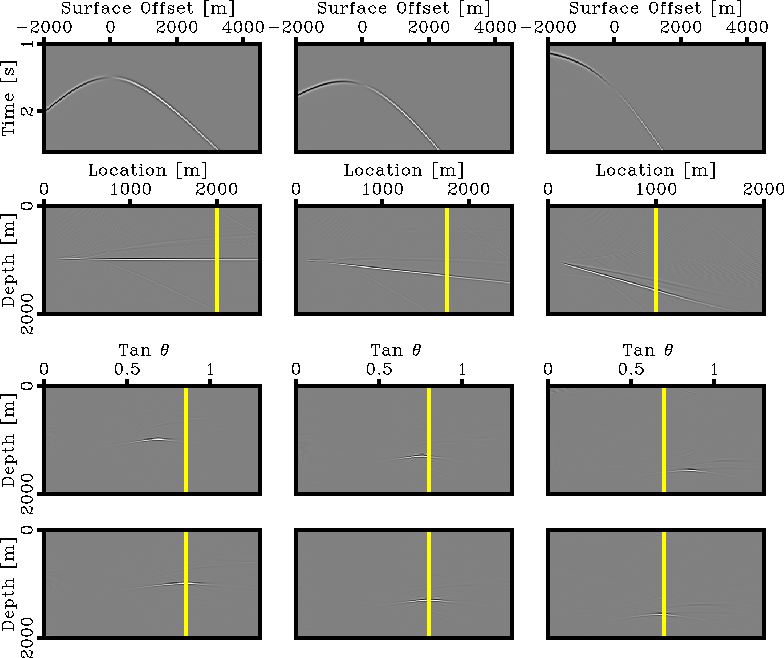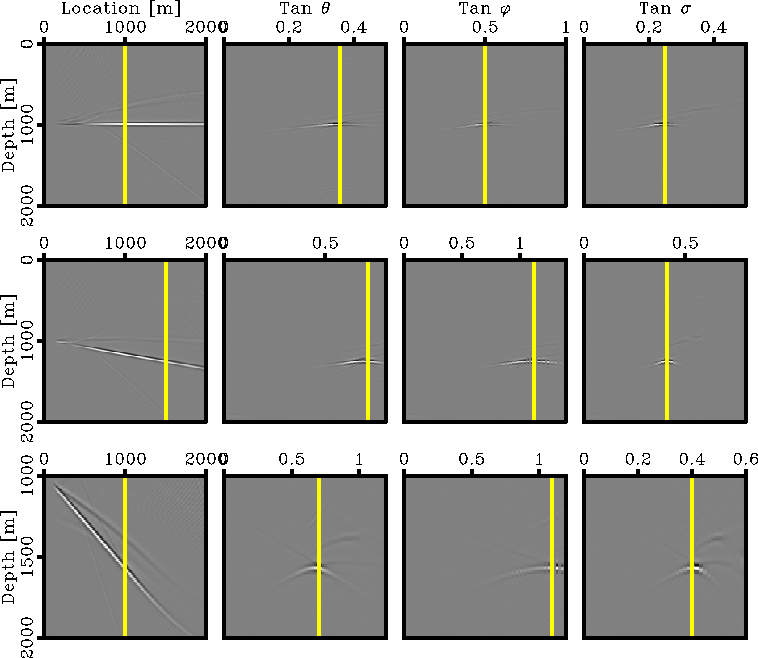![[*]](http://sepwww.stanford.edu/latex2html/cross_ref_motif.gif) . From
left to right we have a flat-layer, a
. From
left to right we have a flat-layer, a
The first example consists of three sections, all of
them displayed in Figure ![[*]](http://sepwww.stanford.edu/latex2html/cross_ref_motif.gif) . From
left to right we have a flat-layer, a
. From
left to right we have a flat-layer, a
![]() dipping layer, and a
dipping layer, and a ![]() dipping
layer. All the sections consist of, from
top to bottom, a single shot gather, an image
from one shot gather, an angle-domain common-image
gather obtained with the conventional methodology, and
the angle-domain common-image gather obtained with
the proposed methodology. The data space consists
of only one shot gather; therefore, the representation
in an ADCIG should have non-zero energy for only one angle.
Table 1 shows the
survey details and the computed angle values
for this experiment. In both angle-domain gathers, the solid
line corresponds to the expected angle value; as expected
the angle gathers obtained with the proposed methodology
perfectly match the values in the table.
dipping
layer. All the sections consist of, from
top to bottom, a single shot gather, an image
from one shot gather, an angle-domain common-image
gather obtained with the conventional methodology, and
the angle-domain common-image gather obtained with
the proposed methodology. The data space consists
of only one shot gather; therefore, the representation
in an ADCIG should have non-zero energy for only one angle.
Table 1 shows the
survey details and the computed angle values
for this experiment. In both angle-domain gathers, the solid
line corresponds to the expected angle value; as expected
the angle gathers obtained with the proposed methodology
perfectly match the values in the table.
 |
| Refl. dip | Shot-loc. | CIG-Loc | |
| Flat layer | 500 | 2000 | |
| 500 | 1750 | ||
| 500 | 1000 |
Our second experiment is also a single-shot experiment.
The intention of this exercise is to present the separation
of the full-aperture angle (![]() ) into its P-incidence
(
) into its P-incidence
(![]() ), and its S-reflection (
), and its S-reflection (![]() ) components.
Figure
) components.
Figure ![[*]](http://sepwww.stanford.edu/latex2html/cross_ref_motif.gif) shows,
from top to bottom, the flat-layer case,
a
shows,
from top to bottom, the flat-layer case,
a ![]() dipping layer case, and a
dipping layer case, and a ![]() dipping
layer case for this experiment. Each case consists of, from left to right,
the image of a single-shot gather; the corresponding
angle-domain common-image gather, which is taken at the
location marked in the image; the corresponding P-angle-domain
common-image gather; and the corresponding S-angle-domain
common-image gather. Table 2 shows the
corresponding values for this experiment.
The solid lines in each of the angle-gathers
represent the computed value in table 2.
dipping
layer case for this experiment. Each case consists of, from left to right,
the image of a single-shot gather; the corresponding
angle-domain common-image gather, which is taken at the
location marked in the image; the corresponding P-angle-domain
common-image gather; and the corresponding S-angle-domain
common-image gather. Table 2 shows the
corresponding values for this experiment.
The solid lines in each of the angle-gathers
represent the computed value in table 2.
 |
| Refl. dip | Shot-loc. | CIG-Loc. | P-angle | S-angle |
| Flat layer | 500 | 1000 | ||
| 500 | 1500 | |||
| 500 | 1000 |
These two synthetic examples clearly show that the proposed methodology accurately transforms SODCIGs into ADCIGs for the converted-mode case. Moreover, we are able to compute the specific incidence and reflection angles.